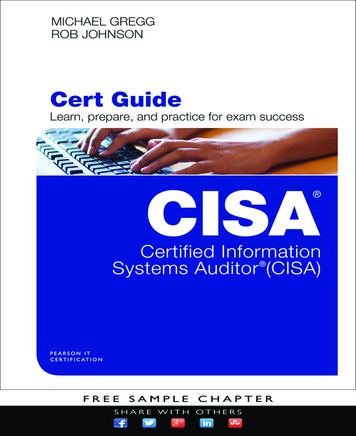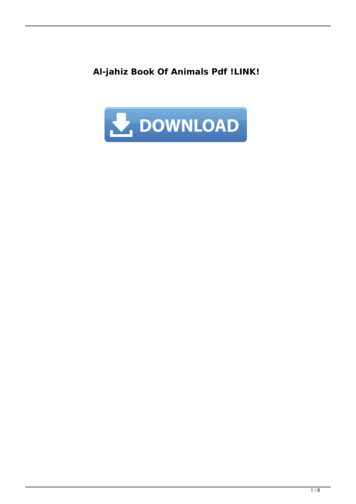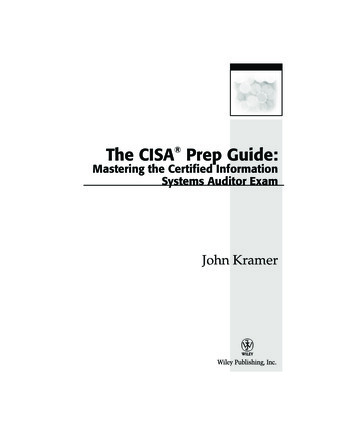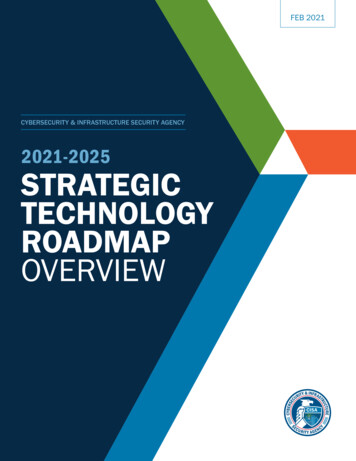
Transcription
Cisa study guide book pdf
Cisa study guide 4th edition pdf.Something went wrong. Wait a moment and try again. CISA clinical research studies use the most current methods and technology to investigate questions of key importance to vaccine safety. Below are brief summaries of CISA clinical research studies. Complete details of these studies are available through the provided links toClinicalTrials.govexternal icon. Observational Maternal COVID-19 Vaccination Studyexternal icon Pregnant people may experience severe complications from Coronavirus disease 2019 (COVID-19), including hospitalization, ICU admission, and need for mechanical ventilation. Babies born to mothers who have COVID-19 may be born premature. CDC’sInterim Clinical Considerations for Use of COVID-19 Vaccines Currently Authorized in the United States recommends that any of the currently authorized COVID-19 vaccines can be administered to pregnant or lactating people. The Advisory Committee on Immunization Practices (ACIP) does not state a product preference. However, there is limitedinformation on the safety of COVID-19 vaccines in pregnant people. The purpose of this CISA study is to learn more about the safety of COVID-19 vaccines in pregnant people and their babies. This study is looking at outcomes among mothers and babies after the mothers receive a COVID-19 vaccine. The study objectives are to examine local andsystemic reactions to the vaccine, adverse events, birth outcomes and infant outcomes. In addition, blood samples from the pregnant people and from infant cord blood are being collected in this study. They may be used to study COVID-19 antibody levels. Lead CISA Site: Duke University Contributing CISA Sites: Cincinnati Children’s Hospital MedicalCenter and Boston Medical Center Collaborator: Centers for Diseases Control and Prevention (CDC) Study start year: 2021 ClinicalTrials.gov Identifier: NCT04826640 Study status: Recruiting ClinicalTrials.gov results posted: No Publications: None Safety of Quadrivalent Recombinant Influenza Vaccine (RIV4) versus Quadrivalent InactivatedInfluenza Vaccine (IIV4) in Pregnant Womenexternal icon The CDC Advisory Committee on Immunization Practices (ACIP) and American College of Obstetricians and Gynecologists (ACOG) recommend that women who are pregnant during the influenza (flu) season receive an influenza vaccine to protect both themselves and their babies frominfluenza. In 2017, ACIP included Recombinant Inactivated Influenza vaccine (RIV4) (Flublok Quadrivalent) as one of the influenza vaccines that can be given to pregnant women. RIV4 is a type of influenza vaccine that is made using an egg-free process. The purpose of this CISA study is to learn more about the safety of RIV4 in pregnant women andtheir babies. This study is comparing the safety of RIV4 with an influenza vaccine that is made using an egg-based process (IIV4). Egg-based influenza vaccines have been in use for decades. Pregnant women enrolled in this study are assigned by chance to receive either RIV4 or IIV4. The study participants and investigators will not know whichvaccine the women received during the study. Health and pregnancy outcomes are assessed in the mothers and their infants. The primary study objective is to compare the proportion of adverse birth outcomes in pregnant women vaccinated with RIV4 versus IIV4. In addition, blood samples from the pregnant women are being collected in this study.They may be used to compare influenza antibody levels in pregnant after RIV4 versus IIV4. Lead CISA Site: Duke University Contributing CISA Sites: Cincinnati Children’s Hospital Medical Center and Boston Medical Center Collaborator: Centers for Diseases Control and Prevention (CDC) Study start year: 2018 ClinicalTrials.gov Identifier:NCT03969641 Study status: Enrollment completed ClinicalTrials.gov results posted: No Publications: None Safety and Immunogenicity of Simultaneous Tetanus Toxoid, Reduced Diphtheria Toxoid, and Acellular Pertussis Vaccine (Tdap) and Inactivated Influenza Vaccine (IIV) in Pregnant Women (Pilot Study)external icon The Advisory Committee onImmunization Practices (ACIP) and American College of Obstetricians and Gynecologists (ACOG) recommend that pregnant women receive an influenza (flu) vaccine if they are pregnant during influenza season, and a tetanus toxoid, reduced diphtheria toxoid, and acellular pertussis vaccine (Tdap) during each pregnancy. Influenza vaccine givenduring pregnancy protects both mothers and their babies from influenza. When a woman receives Tdap during pregnancy, her baby receives some protection from pertussis (whooping cough) until they are old enough to be vaccinated themselves. Giving influenza vaccine and Tdap on the same day may make it easier for more pregnant women to befully immunized. However, there is limited medical information on the health effects of giving both vaccines on the same day versus on different days. CISA conducted this study to look at differences between giving pregnant women inactivated influenza vaccine (IIV) and Tdap on the same day versus on different days. During the 2016-2017 and 20172018 influenza seasons, pregnant women were assigned by chance to receive both Tdap and IIV vaccines on the same day, or on different days (Tdap first, and IIV about 3 weeks later). The study looked at the proportions of pregnant women with reactions at the site of injection and systemic reactions after vaccination, such as fever. The study alsocollected information on the outcomes of the pregnancy including information on the infants. The reactions and pregnancy outcomes in women who get both Tdap and IIV vaccines on the same day are compared with those who get the vaccines on different days. Blood samples were also taken from the pregnant women and their babies. These sampleswere analyzed to assess if giving both Tdap and IIV vaccines on the same day versus different days affects levels of antibodies to the vaccine components in pregnant women and the transfer of these antibodies to their infants. Information from this pilot study may be used to design larger studies to better understand the safety and immune responsesof giving both IIV and Tdap vaccines on the same day in pregnant women. Lead CISA Site: Duke University Contributing CISA Site: Cincinnati Children’s Hospital Medical Center Collaborators: Centers for Diseases Control and Prevention (CDC) and National Vaccine Program Office Study start year: 2015 Study status: Enrollment completedClinicalTrials.gov Identifier: NCT02783170 ClinicalTrials.gov results posted: Yes Publications: None. Tetanus Toxoid, Reduced Diphtheria Toxoid, and Acellular Pertussis Vaccine (Tdap) Safety in Pregnant Womenexternal icon The Advisory Committee on Immunization Practices (ACIP) and American College of Obstetricians and Gynecologists (ACOG)recommend that pregnant women receive a tetanus toxoid, reduced diphtheria toxoid, and acellular pertussis vaccine (Tdap) during each pregnancy. When a woman receives Tdap during pregnancy, her baby receives some protection from pertussis (whooping cough) until they are old enough to be vaccinated themselves. CISA conducted this study tocompare health outcomes after Tdap vaccination in pregnant women versus non-pregnant women. Pregnant women enrolled in the study participated in the study through delivery. The women were monitored for reactions at the site of injection and systemic reactions after vaccination, such as fever. Their infants were also evaluated for healthoutcomes and growth parameters through age 6 months. Non-pregnant women participated for one month after vaccination. Blood samples were also taken to assess levels of antibodies to components of the Tdap vaccine after vaccination in pregnant women and non-pregnant women. This study provided additional information about the safety andimmune responses after Tdap in pregnant women, including repeated Tdap doses. Tdap was well tolerated in pregnant and non-pregnant women. Pregnant women were more likely to report moderate/severe pain at the Tdap injection-site compared with non-pregnant women, but did not need medical visits. Prior Tdap receipt did not increaseoccurrence of moderate/severe injection-site or systemic reactions in pregnant women. Robust immune responses to all vaccine components were seen in both pregnant and non-pregnant women after Tdap. Lead CISA Site: Vanderbilt University Contributing CISA Site: Duke University Collaborators: Centers for Diseases Control and Prevention (CDC)and National Vaccine Program Office Study start year: 2013 Study status: Enrollment completed ClinicalTrials.gov Identifier: NCT02209623 ClinicalTrials.gov results posted: No Publications: Fortner KB, Swamy GK, Broder KR, Jimenez-Truque N, Zhu Y, Moro PL, et al. Reactogenicity and immunogenicity of tetanus toxoid, reduced diphtheria toxoid,and acellular pertussis vaccine (Tdap) in pregnant and nonpregnant women.external icon Vaccine 2018 Oct 8; 36(42): 6354-6360. PregText: Feasibility of Monitoring Influenza Vaccine Safety in Pregnant Women Using Text Messagingexternal icon Text messaging may be a convenient and cost-efficient way to monitor vaccine safety in pregnantwomen, but it had not been studied for this purpose. CISA conducted a study to assess the feasibility of using text messaging to monitor the safety of inactivated influenza (flu) vaccine (IIV) in pregnant women. The study included pregnant women who were less than 20 weeks gestational age at the time they received an inactivated influenza vaccine(IIV) as part of their usual care during the 2013-2014 influenza season. After getting IIV, these women received periodic text messages throughout their pregnancy to 1) monitor for the occurrence of fever shortly after getting the influenza vaccine, and 2) assess pregnancy outcomes. This study demonstrated the feasibility of text messaging forinfluenza vaccine safety surveillance sustained throughout pregnancy. In these women receiving IIV during pregnancy, fever after vaccination was infrequent and a typical pattern of maternal and infant health outcomes was observed. Lead CISA Site: Columbia University Contributing Site: None Collaborator: Centers for Diseases Control andPrevention (CDC) Study start year: 2013 Study status: Enrollment completed ClinicalTrials.gov Identifier: NCT01974050 ClinicalTrials.gov results posted: Yes Publications: Stockwell MS, Cano M, Jakob K et al. Feasibility of Text Message Influenza Vaccine Safety Monitoring During Pregnancyexternal icon. Am J Prev Med.external icon 2017 May 2.pii: S0749-3797(17)30204-0. Apnea in Hospitalized Preterm Infants Following the Administration of Routine Childhood Vaccinesexternal icon Except for the birth dose of hepatitis B vaccine, the Advisory Committee on Immunization Practices (ACIP) and the American Academy of Pediatrics (AAP) recommend that preterm infants should be vaccinatedat the same age and according to the same schedule as full-term infants. This includes preterm infants who remain hospitalized after birth. Apnea (i.e. brief stopping of breathing) is common in babies born prematurely. Some preterm babies may have episodes of apnea shortly after they receive vaccines, but it is not known if the vaccines contribute tothe apnea or if this occurs by chance. Concern about apnea after vaccination contributes to the underimmunization of preterm infants. CISA is conducting this study to assess if apnea is more likely to occur in preterm infants after receipt of routine childhood vaccines. The study also looks at the severity of apnea events shortly after preterm infantsare vaccinated. Preterm infants born at or earlier than 32 weeks gestational age who have remained hospitalized since birth, and are eligible to receive 2-month recommended vaccines are assigned by chance to a “vaccinated” or “unvaccinated” group. Both groups are monitored for apnea for at least 48 hours after they are assigned to the group.The study compares the proportion of infants who have apnea during the 48 hours after vaccination in the “vaccinated” group versus during 48 hours after group assignment in the “unvaccinated” group. Healthcare providers for the infants assigned to the “unvaccinated” group will make the decision on when to vaccinate the infants after their
participation in the study. Information from this study may lead to a better understanding of apnea after vaccination and help healthcare providers and parents make decisions about vaccinating preterm infants. Lead CISA Site: Duke University (Sub-contracting site: University of North Carolina) Contributing Site: Cincinnati Children’s HospitalMedical Center Collaborator: Centers for Diseases Control and Prevention (CDC) Study start year: 2017 Study status: In progress ClinicalTrials.gov Identifier: NCT03530124 ClinicalTrials.gov results posted: No Publications: None Fever after Simultaneous versus Sequential Vaccination in Young Childrenexternal icon In recent years, some studieshave suggested that giving the inactivated influenza (flu) vaccine (IIV) with 13-valent pneumococcal conjugate vaccine (PCV13) and/or diphtheria, tetanus toxoids, and acellular pertussis adsorbed (DTaP) on the same day is associated with an increased risk of febrile seizure in young children. However, some other studies have not shown thisincreased risk for febrile seizures. CDC’s Vaccine Information Statement for IIV ( pdf icon[PDF – 2 pages]) notes this possible increased risk of febrile seizure in young children who get IIV with PCV 13 and/or DTaP vaccine on the same day. CISA conducted this study in young children to improve understanding of fever after vaccination on the sameday compared with vaccination on separate days. Fever is a common event after vaccination and it is reasonable to study fever after vaccination to learn more about febrile seizure risk after vaccination. In this CISA study, healthy children aged 12-16 months had two study visits about two weeks apart during the 2017-2018 influenza season. Thechildren were assigned by chance to receive study vaccines on the same visit (simultaneous group) or at two separate visits (sequential group). Children in the simultaneous group received IIV, PCV13 and DTaP at Visit 1 and health education without vaccines at Visit 2. Children in the sequential group received PCV13 and DTaP together at Visit 1 andthen IIV at Visit 2. Children may have received other recommended vaccines at Visit 1, but not Visit 2. After each visit, children were monitored for fever, other health outcomes, and having an unscheduled medical visit. The primary objective of the study is to compare the proportions of children with fever in the first 2 days following Visit 1 and Visit 2combined. Information from this study may lead to a better understanding of the risk of fever when IIV is given on the same day as PCV13 and DTaP vaccines. This information could also provide anticipatory guidance to parents about fever after receipt of multiple vaccines on the same day. Lead CISA Site: Duke University Contributing Site: KaiserPermanente Northern California Collaborator: Centers for Diseases Control and Prevention (CDC) Study start year: 2016 Study status: Enrollment completed ClinicalTrials.gov Identifier: NCT03165981 ClinicalTrials.gov results posted: Yes Publications: Walter EB, Klein NP, Wodi AP, Roundtree W, Todd CA, Wiesner A, Duffy J, Marquez PL, Broder K.Fever after Influenza, Diphtheria-Tetanus-Acellular Pertussis, and Pneumococcal Vaccinations.external icon Pediatrics. 2020 Mar;145(3):e20191909. Potential Mechanisms for Intussusception after Rotavirus Vaccine-Pilot Studyexternal icon The Advisory Committee on Immunization Practices (ACIP) recommends rotavirus vaccination for infants.Rotavirus vaccination is associated with an increased risk for intussusception (i.e. the telescoping of one portion of the intestine into another). CDC’s Vaccine Information Statement for rotavirus vaccine notes this increased risk. The reason for this increased risk of intussusception is unknown. CISA conducted this study to improve understanding ofthe occurrence of rotavirus vaccine-associated intussusception. The study looked at the effects of the first dose of rotavirus vaccination on the structure and movement of the intestines, and on cytokines in the blood and stool. Cytokines are substances that are secreted by immune cells and act on other cells to coordinate appropriate immuneresponses. The association between these outcomes and the pattern of the shedding of vaccine strain rotavirus in the stool is also being evaluated. Healthy infants aged 6-13 weeks were assigned by chance to be vaccinated in one of the following ways listed below. The parents and study investigators did not know which group the infants wereassigned to during the study. Monovalent rotavirus vaccine (Rotarix ) alone Rotarix with other vaccines routinely recommended at 2-months of age Pentavalent rotavirus vaccine (RotaTeq ) alone RotaTeq with other vaccines routinely recommended at 2-months of age The infants in this study had an MRI and ultrasound of their gastrointestinaltract before, and about 5 days after vaccination. The study also collected information about vaccine reactions, such as fever, and collected samples of blood and stool from the infants before and after vaccination. Information from this pilot study may be used to assess the feasibility of conducting a larger scale study. Information may also helpunderstand possible reasons why rotavirus vaccine is associated with an increased risk for intussusception. Lead CISA Site: Cincinnati Children Hospital Medical Center Contributing Site: None Collaborator: Centers for Diseases Control and Prevention (CDC) Study start year: 2014 Study status: Enrollment completed ClinicalTrials.gov Identifier:NCT02542462 ClinicalTrials.gov results posted: Yes Publications: None The Effect of Prophylactic Antipyretics on Immune Responses and Fever after 2014-2015 and 2015-2016 Inactivated Influenza Vaccine (IIV)external icon Antipyretics [such as acetaminophen (e.g. Tylenol ) or ibuprofen (e.g. Motrin ] are fever-reducing medicines. Using feverreducing medications immediately after vaccination and during the next 24 hours can prevent the occurrence of fever after vaccination. However, giving these medicines to prevent fever after vaccination may also decrease immune responses to vaccine in children. CISA conducted this study to assess the effect of fever-reducing medications on theimmune responses and rates of fever after inactivated influenza (flu) vaccine (IIV). This study enrolled healthy children 6-47 months of age during the 2014-2015 and 2015-2016 influenza seasons. This study used lessons learned from a pilot study conducted by CISA during the 2013-2014 influenza season (learn more information about the Pilot Studyto Assess the Effect of Prophylactic Antipyretics on Immune Response and Fever After IIV – NCT01946594external icon). In this study, children were assigned by chance to be in one of three groups: the first group of children received acetaminophen, the second group received a placebo – a substance containing no medicine, and the third group ofchildren received ibuprofen. In groups one and two the child, parent and study investigator were blinded and did not know the study group assignment. Group three was not blinded. Children in all groups received IIV and then received doses on the study medicine immediately after vaccination and for the next 24 hours. Children were followed forthe occurrence of vaccine reactions, such as fever, and having an unscheduled medical visit on the day of, and for two days following IIV vaccination. Blood samples were also taken to check antibody levels to the 2014-2015 and 2015-2016 influenza vaccines before, and about four weeks after IIV was given. There were no significant differences inantibody levels to influenza vaccine in the children who received fever-reducing medicine vs. placebo. Our results do not suggest any blunting of the immune response to IIV when fever-reducing medicines are given to children shortly after IIV vaccination. Studies with larger sample sizes are needed to definitively establish the effect of antipyretics onimmune responses after IIV. Lead CISA Site: Duke University Contributing site: None Collaborator: Centers for Diseases Control and Prevention Study start year: 2014 Study status: Enrollment completed ClinicalTrials.gov Identifier: NCT02212990 ClinicalTrials.gov results posted: No Publications: Walter EB, Hornik CP, Grohskopf L, McGee CE, ToddCA, Museru OI, Harrington L, Broder KR. The effect of antipyretics on immune response and fever following receipt of inactivated influenza vaccine in young childrenexternal icon. Vaccine. 2017 Dec 4; 35(48 Pt B): 6664–6671. Assessing Fever Rates in Children ages 24 to 59 months after Live Attenuated Influenza Vaccine (LAIV) or InactivatedInfluenza Vaccines (IIV) Using Text Messaging for U.S. influenza vaccines in 2012–13 & 2013-2014external icon Some children have fevers after receiving vaccines, including influenza (flu) vaccines. In recent years there have been four types of flu vaccines for children: trivalent inactivated influenza vaccine (3 strain, flu shot) (IIV3), trivalent liveattenuated influenza vaccine (3 strain, nasal spray) (LAIV3), quadrivalent inactivated influenza vaccine (4 strain, flu shot) (IIV4), and quadrivalent live attenuated influenza vaccine (4 strain, nasal spray) (LAIV4). CISA conducted this study to assess rates of fever in healthy children aged 24-59 months after they received pediatric influenza vaccines.The main study objective is to compare rates of fever after LAIV3/LAIV4 versus IIV3/IIV4 on the day of vaccination through two days after vaccination. After vaccination, parents took their children’s temperature beginning on the day of vaccination (day 0) through 10 days after vaccination. The parents sent the temperature readings to study staffusing text messaging each day. Fever frequencies after influenza vaccination were low overall and did not differ according to influenza vaccine type during the 2013–2014 influenza season. The results of this study further support the use of text messaging for monitoring vaccine adverse events, because response rates to text messages were highcompared to response rates to other sources, such as a paper diary, and results were similar when analyses were limited to text message data. In a companion study, dried blood spot samples were collected in some children to learn more about the feasibility of collecting dried blood spot samples after vaccination in children with fever. It may beuseful in future studies to analyze dried blood spots to look for biomarkers associated with febrile reactions in children who receive influenza vaccines. Lead CISA Site: Columbia University Contributing site: None Collaborator: Centers for Diseases Control and Prevention (CDC) Study start year: 2012 Study status: Enrollment completedClinicalTrials.gov Identifier: NCT01764269 ClinicalTrials.gov results posted: No Publication: Stockwell MS, Broder KR, Lewis P et al. Assessing Fever Frequency After Pediatric Live Attenuated Versus Inactivated Influenza Vaccinationexternal icon. J Pediatric Infect Dis Soc. 2017 Sep 1; 6(3):e7-e14. Preventing Post-Vaccination Presyncope inAdolescents Using Simple, Clinic-based Interventionsexternal icon Syncope (fainting) after vaccination is uncommon but may lead to severe injuries when it occurs. Some people may experience symptoms of presyncope, such as feeling faint or lightheaded, after vaccination before they faint. This study built on the findings from an earlier studyconducted by CISA that suggested possible simple, low-cost interventions might be useful to prevent fainting or feeling faint after vaccination. Learn more information about the earlier study, Oral Water Hydration to Prevent Post-Vaccination Presyncope – NCT02353390external icon. Two possible interventions to prevent fainting or feelingfaint/lightheaded after vaccination are: 1) drug-free pain prevention intervention (Buzzy ) and 2) distraction/anxiety-reducing intervention (listening to music). CISA conducted this pilot study to assess if it was feasible and acceptable to adolescents to implement these simple interventions in a clinic setting. Adolescents aged 10-17 years wereassigned by chance to one of three groups before vaccination: 1) Buzzy alone, 2) music alone, or 3) Buzzy and music together. These interventions were applied before and during vaccination, and adolescents were assessed for symptoms of presyncope and syncope. Feasibility of using the interventions was assessed by the ability of study staff tosuccessfully administer the interventions, and by both study staff and healthcare provider responses to written feasibility assessments. Acceptability was assessed by self-report of the adolescent participants. The pilot study suggested that adolescents found the Buzzy and music interventions to be acceptable, and that it would be feasible to studythese simple interventions further to prevent presyncope and syncope and associated injuries after vaccination. Lead CISA Site: Duke University Contributing Sites: None Collaborator: Centers for Diseases Control (CDC) Study start year: 2017 Study status: Enrollment completed. ClinicalTrials.gov Identifier: NCT03533829 ClinicalTrials.gov resultsposted: Yes Publications: None Oral Water Hydration to Prevent Post-Vaccination Presyncopeexternal icon Syncope (fainting) after vaccination is uncommon but may lead to severe injuries when it occurs. Some people may experience symptoms of presyncope, such as feeling faint or lightheaded, after vaccination before they faint. The AdvisoryCommittee on Immunization Practices (ACIP) and American Academy of Pediatrics (AAP) recommend that all adolescents be sitting or lying down during vaccination to help prevent fainting. Providers should also consider observing patients for at least 15 minutes after vaccination to prevent potential injuries related to fainting after vaccination.Studies suggest drinking 500 ml of water within fifteen minutes before venipuncture (i.e. puncturing a vein) can help prevent feeling faint or lightheaded among blood donors. It was not known if drinking water would also prevent presyncope or syncope after vaccination. CISA conducted this study in adolescents and young adults (aged 11-21 years)receiving at least one vaccine that is injected into a muscle. Study participants were assigned by chance to drink a 500mL bottle of water shortly before vaccination or to receive routine care before vaccination. This study determined whether drinking water shortly before vaccination decreases the rate of feeling faint in adolescents and young adults.The study also evaluated whether drinking water before vaccination is acceptable to adolescents and young adults. The study did not find that drinking water before vaccination was effective in reducing presyncope symptoms after vaccination in adolescents and young adults. However, the study did identify factors associated with presyncope aftervaccination that could be targeted in future research to develop prevention strategies. Lead CISA Site: Duke University Contributing CISA Site: Boston Medical Center Collaborator: Centers for Diseases Control and Prevention (CDC) Study start year: 2014 Study status: Enrollment completed ClinicalTrials.gov Identifier: NCT02353390ClinicalTrials.gov results posted: No Publications: Kemper AR, Barnett ED, Walter EB, et al. Drinking Water to Prevent Postvaccination Presyncope in Adolescents: A Randomized Trialexternal icon. Pediatrics. 2017 Nov; 140(5): e20170508. Clinical Study of the Safety of Quadrivalent Live Attenuated Influenza Vaccine (LAIV4) in Children with Asthmaof Varying Levels of Severityexternal icon The Advisory Committee on Immunization Practices (ACIP) recommends people aged 6 months and older receive influenza (flu) vaccine each influenza season. People can receive either the inactivated influenza vaccine (IIV) (flu shot) or live-attenuated influenza vaccine (LAIV) (nasal spray). This influenzavaccine recommendation is particularly important for persons at elevated risk from complications of influenza, including children with asthma. Asthma is a condition that inflames and narrows the airways in the lungs and can lead to symptoms such as coughing and wheezing. ACIP considers use of LAIV in persons with asthma aged 5 years and olderto be a precaution due to the potential increased risk for wheezing after LAIV. CISA is conducting this study to evaluate whether LAIV is as safe as IIV in children with asthma. These vaccines are approved for use in the United States. This study applies lessons learned from an earlier feasibility conducted by the CISA Project during the 2016-2017influenza season. Learn more information about the pilot study Influenza Vaccine Feasibility Study in Children with Persistent Asthma – NCT02967393external icon. Children aged 5-17 years are assigned by chance to receive either the quadrivalent nasal spray flu (LAIV4) or quadrivalent flu shot (IIV4). The children are monitored for symptoms ofasthma and other health outcomes for 6 weeks after vaccination. The primary objective of this study is to compare the proportion of children with an asthma exacerbation (flare-up) after LAIV4 versus IIV4. The study also compares asthma symptoms and vaccine reaction symptoms such as fever, between children in the two groups. Information fromthis study could help healthcare providers and parents make decisions about influenza vaccination in children with asthma. Lead CISA Site: Vanderbilt University Contributing Sites: Cincinnati Children’s Hospital Medical Center and Duke University Collaborator: Centers for Diseases Control and Prevention (CDC) Study Start year: 2015 Study status:Enrollment completed ClinicalTrials.gov Identifier: NCT03600428 ClinicalTrials.gov r
Cisa study guide 4th edition pdf. Something went wrong. Wait a moment and try again. CISA clinical research studies use the most current methods and technology to investigate questions of key importance to vaccine safety. Below are brief summaries of CISA clinical research studies. Complete details of these studies are available through the .










